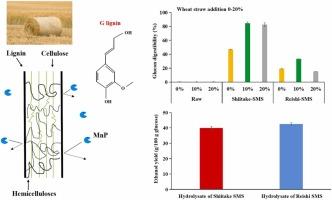Investigation of crop straw for edible and medicinal fungi cultivation: Assessment of lignocellulose preprocessing and spent substrate biofuel properties
IF 5.6
1区 农林科学
Q1 AGRICULTURAL ENGINEERING
引用次数: 0
Abstract
Pretreatment with white-rot fungi has advantages of low inputs of energy and chemicals for reducing the recalcitrance of woody biomass for cellulosic ethanol production. This study investigated the effects of substrates ranging from wood to wheat straw on edible and medicinal fungi production, lignocellulose degradation, cellulose saccharification and ethanolic fermentation of the produced hydrolysates. Shiitake cultivation resulted in the most substantial degradation of lignin and xylan. Reishi produced a selective degradation pattern in terms of preferential xylan removal. Oyster had poor performance in lignocellulose degradation. Shiitake and reishi had high reactivity of S-lignin. The strong recalcitrance of >10 % wheat straw addition for mushroom cultivation might be attributed to the low S:G ratio of the substrates. Compared with the substrate comprising a single hardwood, 10 % wheat straw addition optimised the integration process, resulting in a generally comparable fruiting body yield and higher lignocellulose degradation. The shiitake-based and reishi-based spent mushroom substrates (SMSs) contained ∼21 % glucan, which released 84.4 % and 33.5 % of potentially achievable glucose upon enzymatic saccharification, respectively. The SMS hydrolysates ensured ethanol yields corresponding to 78.0 %–83.2 % of the theoretical value in fermentation. The lignocellulose degradation–derived by-products following the fungal pretreatment showed a notable difference compared with thermochemical methods and might cause inhibitory effects on yeast. This study provides valuable insights into the cause of crop straws’s inhibition of white-rot fungi production and reveals the potential of fungal pretreatment as a biorefinery approach producing food and biofuel.

农作物秸秆用于食用和药用真菌培养的研究:木质纤维素预处理和废基质生物燃料特性评估
使用白腐真菌进行预处理具有能源和化学品投入低的优势,可减少用于纤维素乙醇生产的木质生物质的不稳定性。本研究调查了从木材到小麦秸秆等各种基质对食用和药用真菌生产、木质纤维素降解、纤维素糖化以及水解产物乙醇发酵的影响。香菇栽培对木质素和木聚糖的降解作用最大。灵芝产生了一种选择性降解模式,优先去除木聚糖。牡蛎在降解木质纤维素方面表现较差。香菇和灵芝对 S-木质素有较高的反应活性。在蘑菇栽培中添加 10% 的小麦秸秆会产生强烈的不稳定性,这可能是由于基质的 S:G 比率较低。与含有单一硬木的基质相比,添加 10% 的小麦秸秆可优化整合过程,使子实体产量基本相当,木质纤维素降解率更高。香菇基质和灵芝基质的废蘑菇基质(SMS)含有 21% 的葡聚糖,经酶糖化后分别释放出 84.4% 和 33.5% 的潜在葡萄糖。SMS 水解产物可确保乙醇产量达到发酵理论值的 78.0%-83.2% 。与热化学方法相比,真菌预处理后木质纤维素降解产生的副产品有明显差异,可能会对酵母产生抑制作用。这项研究对作物秸秆抑制白腐真菌产生的原因提供了有价值的见解,并揭示了真菌预处理作为一种生产食品和生物燃料的生物炼制方法的潜力。
本文章由计算机程序翻译,如有差异,请以英文原文为准。
求助全文
约1分钟内获得全文
求助全文
来源期刊

Industrial Crops and Products
农林科学-农业工程
CiteScore
9.50
自引率
8.50%
发文量
1518
审稿时长
43 days
期刊介绍:
Industrial Crops and Products is an International Journal publishing academic and industrial research on industrial (defined as non-food/non-feed) crops and products. Papers concern both crop-oriented and bio-based materials from crops-oriented research, and should be of interest to an international audience, hypothesis driven, and where comparisons are made statistics performed.
 求助内容:
求助内容: 应助结果提醒方式:
应助结果提醒方式:


